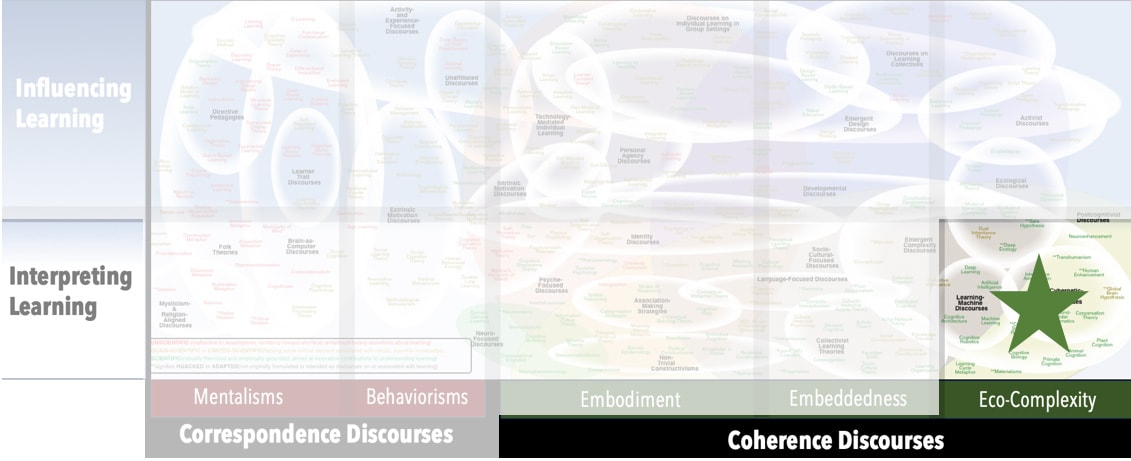Focus
Mimicking and modeling human cognitionPrincipal Metaphors
- Knowledge is … ever-expanding scope of possible functioning
- Knowing is … recognizing forms and recommending actions (enabled and constrained by current base of analyzed information)
- Learner is … a computer architecture
- Learning is … organizing, analyzing, connecting, and extending information
- Teaching is … self-teaching through recursive learning cycles
Originated
1960sSynopsis
A Cognitive Architecture is a computer model of the human mind. That is, a Cognitive Architecture is an electronic system designed to mimic the structural properties and the behaviors of an intelligent cognitive system. Many have been developed, principally as tools to investigate and refine theories of cognition. Most have been strongly influenced by:- Unified Theory of Cognition (Allan Newell, 1990s) – a proposal for a set of general assumptions that can be used to generate models that encompass all aspects of cognition (defined to include, among other elements, perception, motor behavior, motivation, memory, emotion problem solving, language, imagination, and autonomy)
- ACT-R (Adaptive Control of Thought – Rational) (John R. Anderson, Christian Lebiere, 1990s) – inspired by cognitive neuroscience, aims to define the basic and irreducible operations that enable the human mind
- CLARION (Connectionist Learning with Adaptive Rule Induction ON-line) (Ron Sun, 2000s) – a computational architecture focused on utilizing interactions between implicit and explicit processes
- Copycat (Douglas Hofstadter, Melanie Mitchell, 1980s) – a model of human cognition that focuses on analogy making
- DeepMind (Google, 2010s) – a neural network capable of learning to play video games in a manner similar to humans
- GPS (General Problem Solver) (Allen Newell, 1950s) – a simulation program offered as a theory of how humans solve problems
- Soar (Allen Newell, John Laird, 1980s) – focused on computational building blocks that are necessary for agents able to make decisions, solve problems, plan, and understand natural language.
- Society of Mind (Marvin Minsky, 1980s) – a theory of natural intelligence based on mindless “agents” whose interactions contribute to a transcendent awareness
- Subsumption Robotic Architectures (Rodney Brooks, 1980s) – rejecting efforts to model human intelligence in terms of symbol manipulation, this approach is based on bottom-up, real-time interactions with a world
Commentary
Considered across the many, many Cognitive Architecture models that have been developed since the 1970s, great contributions have been made to both understanding human cognition and developing Artificial Intelligence. Many researchers involved in Cognitive Architecture invoke a “brain as computer” metaphor to describe their work, even though the notion has a checkered history (see Brain-as-Computer Discourses, esp. Cognitivism).Authors and/or Prominent Influences
Herbert A. Simon; Allen Newell; John R. AndersonStatus as a Theory of Learning
A Cognitive Architecture is, by definition, a theory of cognition – and so, by implication, a Cognitive Architecture entails a theory of learning. That is, each of these initiatives aims to offer useful insights into how humans learn.Status as a Theory of Teaching
A Cognitive Architecture is not a theory of teaching.Status as a Scientific Theory
A Cognitive Architecture is a scientific theory. The starting place of assembling any Cognitive Architecture is an effort to be explicit about assumptions on how human minds work. And every Cognitive Architecture is eventually subjected to rigorous testing and demonstrations.Subdiscourses:
- ACT-R (Adaptive Control of Thought – Rational)
- CLARION
- Copycat
- DeepMind
- GPS (General Problem Solver)
- Society of Mind
- Soar
- Subsumption Robotic Architectures
- Unified Theory of Cognition
Map Location

Please cite this article as:
Davis, B., & Francis, K. (2023). “Cognitive Architecture” in Discourses on Learning in Education. https://learningdiscourses.com.
⇦ Back to Map
⇦ Back to List
